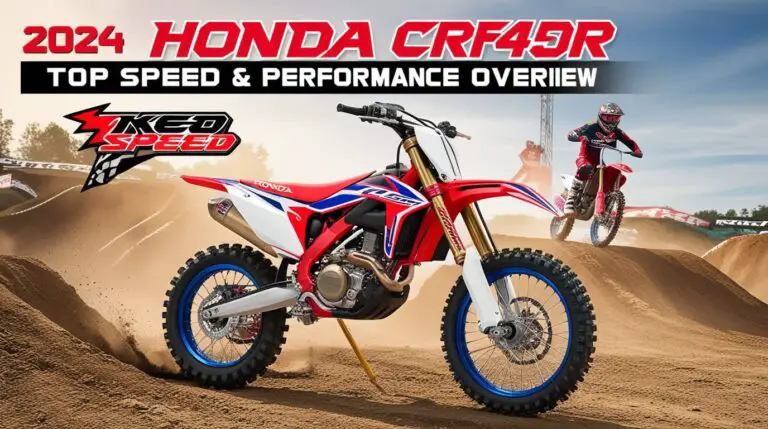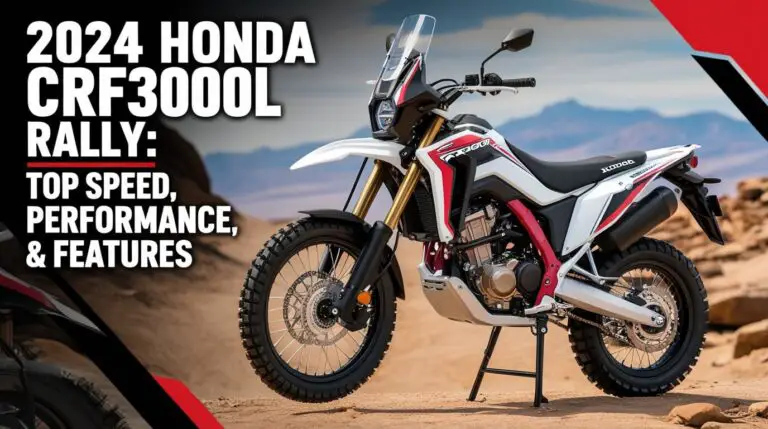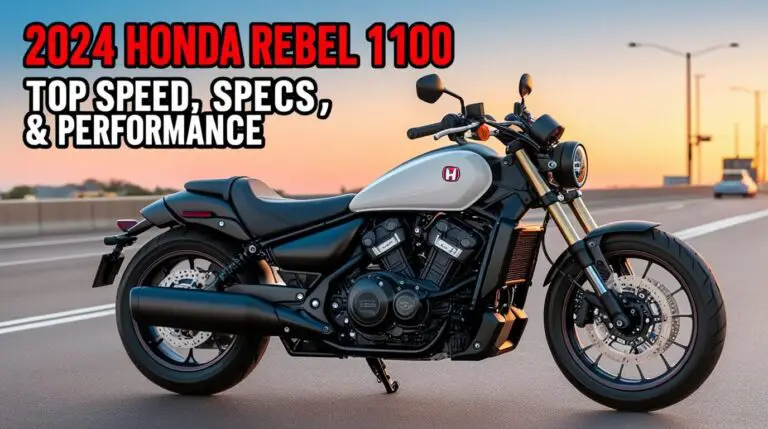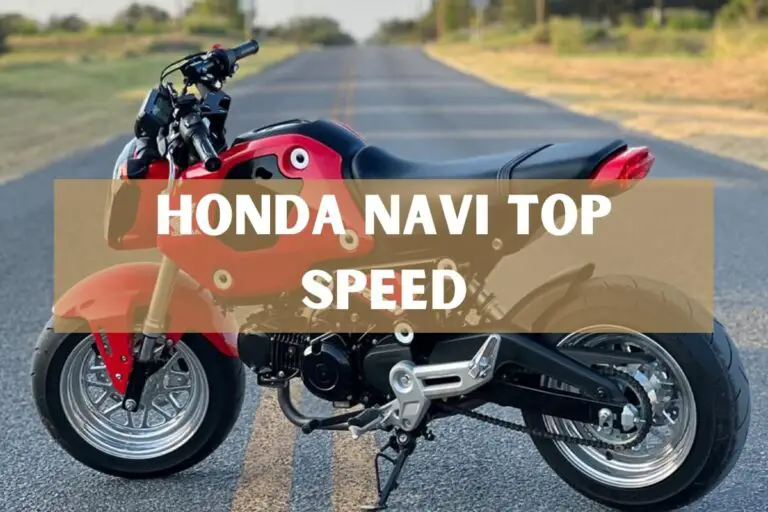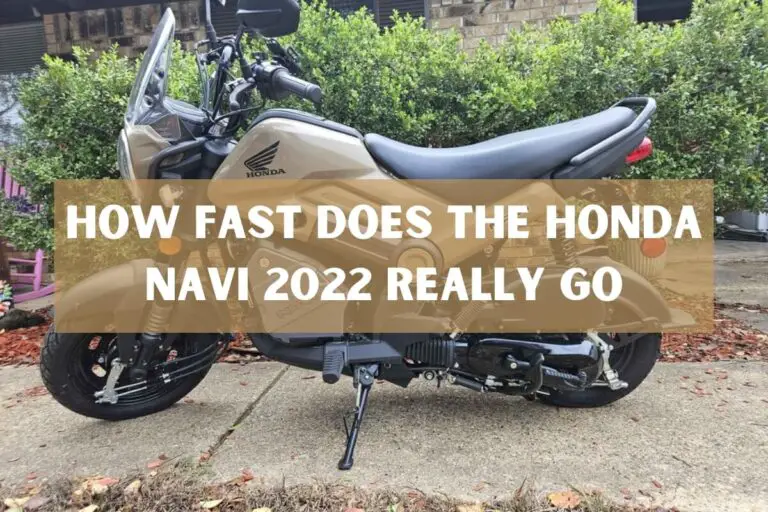The Honda Rebel 300’s Performance & Top Speed
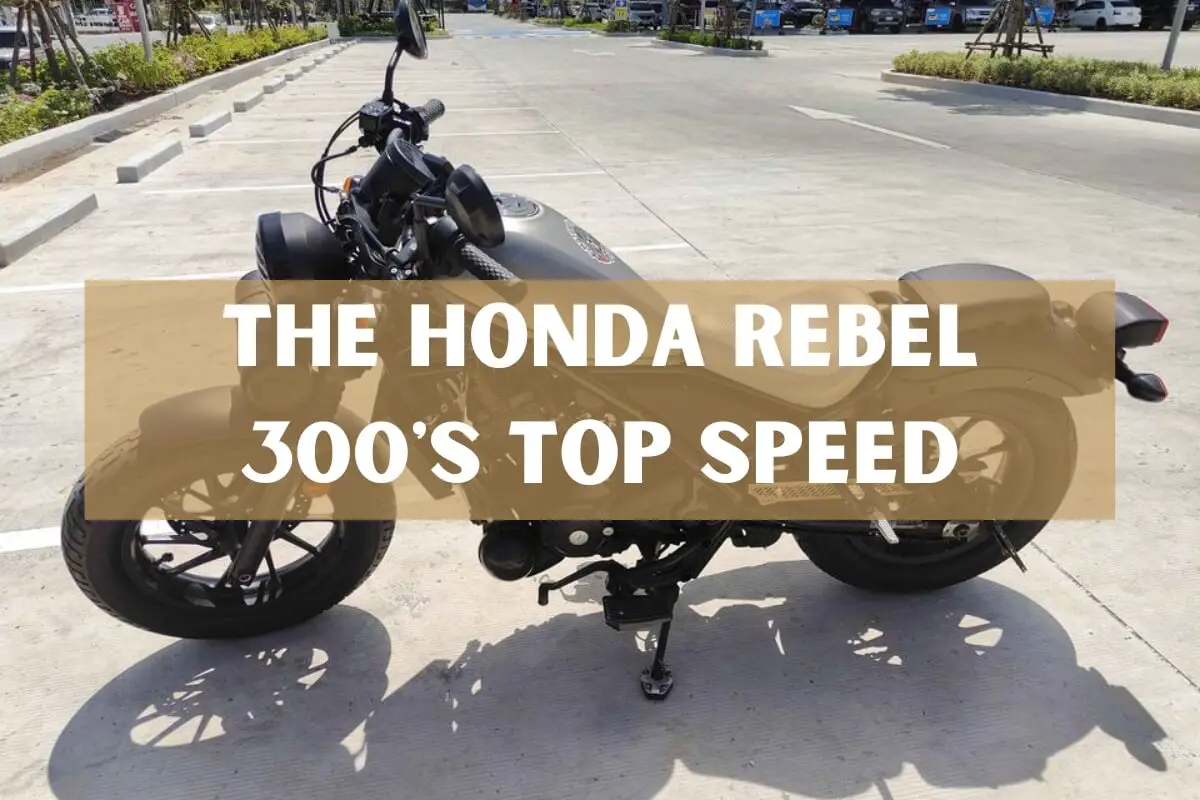
The Honda Rebel 300 is one of Honda’s most popular cruiser motorcycles thanks to its easy handling, approachable seat height of 27.2 inches, and vintage styling. But how fast can this little 286cc liquid-cooled single-cylinder four-stroke machine really go?
What is the top speed of the Honda Rebel 300 and how does its acceleration, 27.4 horsepower, and overall performance stack up?
The Rebel 300 is capable of reaching a top speed of 95 mph depending on riders weight and road conditions. While not as fast as larger displacement cruisers, it has plenty of usable power for around-town riding and short highway stints.
In this detailed review, we’ll cover everything you need to know about the Rebel 300’s 286cc engine specs, real-world top speed of 95 mph, acceleration, ride quality, and more. Plus, how various mods like exhaust and air intake changes can eke out some extra horses and mph.
Honda Rebel 300 Overview

The 2023 Honda Rebel 300 continues the new generation of Honda’s iconic entry-level cruiser introduced with the 2018 model. Offered alongside the bigger Rebel 500, the 300 model maintains the retro styling theme but with updated modern technology like LED lighting and available anti-lock brakes (ABS).
With a low 27.2-inch seat height, relaxed ergonomics, and lightweight 364 lb curb weight, the Rebel 300 remains a favorite for newer riders and those of smaller stature. Its unintimidating nature also appeals to riders who want a friendly, manageable cruiser to run around town on.
“The Honda Rebel 300 has plenty of power from its 286cc engine for around town riding while being lightweight and easy to handle.”
While the 286cc liquid-cooled single-cylinder four-stroke engine struggles at sustained speeds above 95 mph, it offers plenty of usable power for most urban duties. Factor in the comfy riding position, excellent 95 mpg fuel efficiency, and affordable $4,749 MSRP price, and it’s easy to see why the unassuming Rebel 300 continues selling well.
Honda Rebel 300 Specs and Features
Before getting into performance numbers, let’s look at some key specs for understanding what the Rebel 300 brings to the table:
| Specification | Details |
|---|---|
| Engine | 286cc liquid-cooled single-cylinder four-stroke |
| Transmission | Six-speed |
| Top Speed | 95 mph |
| Mileage | 95 mpg (40.4 km/l) |
| Wheelbase | 58.7 in. (1491 mm) |
| Seat Height | 27.2 in. (690.9 mm) |
| Suspension Front | 41mm fork; 4.8-inch travel |
| Suspension Rear | Dual shocks; 5.5-inch travel |
| Brakes Front | Single 296mm disc; ABS |
| Brakes Rear | Single 240mm disc; ABS |
| Tires Front | 130/90-16 |
| Tires Rear | 150/80-16 |
| Fuel Capacity | 3.0 gal. (11.4 l) |
| Curb Weight | 364 lb. (165.1 kg) |
| Rake | 28.0° |
| Trail | 4.3 in. (109.2 mm) |
| Power | 27.4 horsepower |
| Torque | 19.9 ft-lbs (27 Nm) |
| Bore x Stroke | 76.0mm x 63.0mm |
| Compression Ratio | 10.7:1 |
| Valve Train | DOHC; four valves per cylinder |
| Induction | Programmed Fuel Injection (PGM-FI); 38mm throttle body |
| Final Drive | O-ring-sealed chain; 14T/36T |
| MSRP Price | $4,749 |
Some standout numbers from the above table:
- Low seat height of 27.2 inches – Makes it comfy for shorter riders
- Relaxed rake and trail geometry for easy steering
- Just 364 lb curb weight for maneuverability
- Capable chassis and suspension travel numbers
Next let’s look at the engine’s horsepower and torque output to understand what gives the Rebel 300 its pep.
Honda Rebel 300 Horsepower and Torque
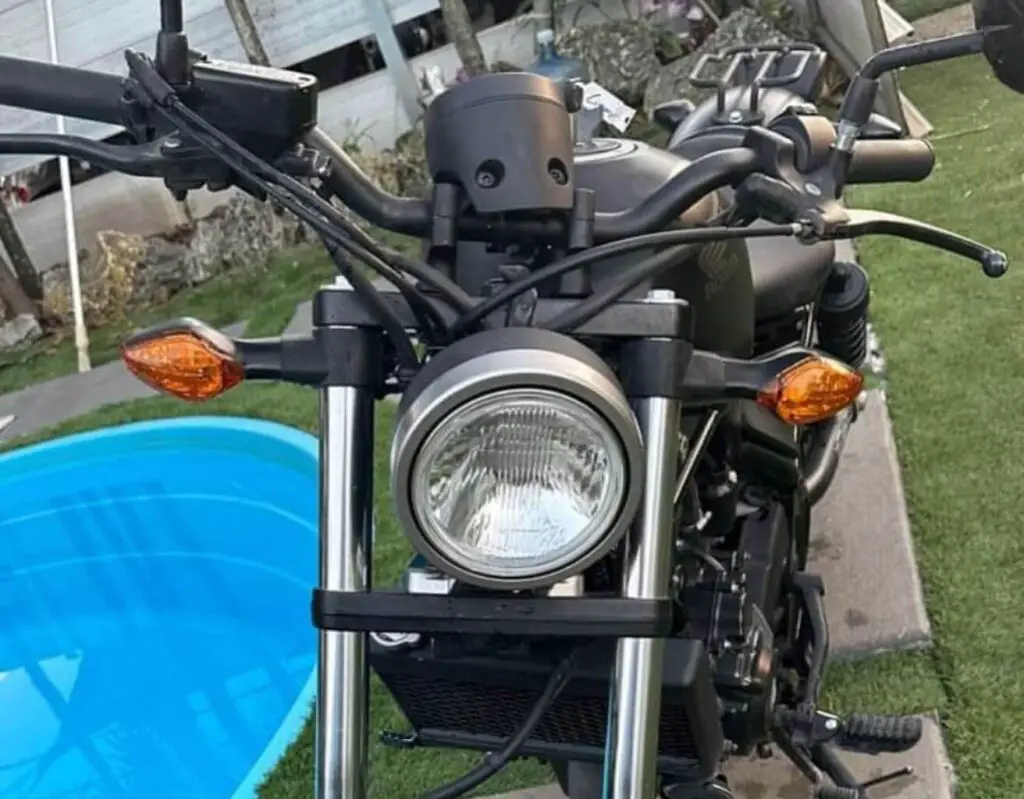
The Rebel 300’s engine might be small at just 286cc, but it puts out very respectable numbers for its size and configuration:
- 27.4 max horsepower at 8,500 RPM
- 19.9 ft-lbs peak torque at 6,500 RPM
That horsepower figure matches or exceeds some other 300-400cc class rivals, while the healthy torque output is what gives the bike great around-town acceleration and usability.
It provides ample power for everyday street riding, though performance does drop off at sustained highway speeds approaching the Rebel’s top speed of 95 mph. There just isn’t enough grunt to maintain speeds above 75-80 mph comfortably for extended periods.
“There’s enough power for zipping around town easily. Getting to 60 mph happens quickly from a stop. But engine feels buzzy pushing past 80 on the freeway.”
“There’s enough power for zipping around town easily. Getting to 60 mph happens quickly from a stop. But engine feels buzzy pushing past 80 on the freeway.”
What is the Honda Rebel 300’s Top Speed?
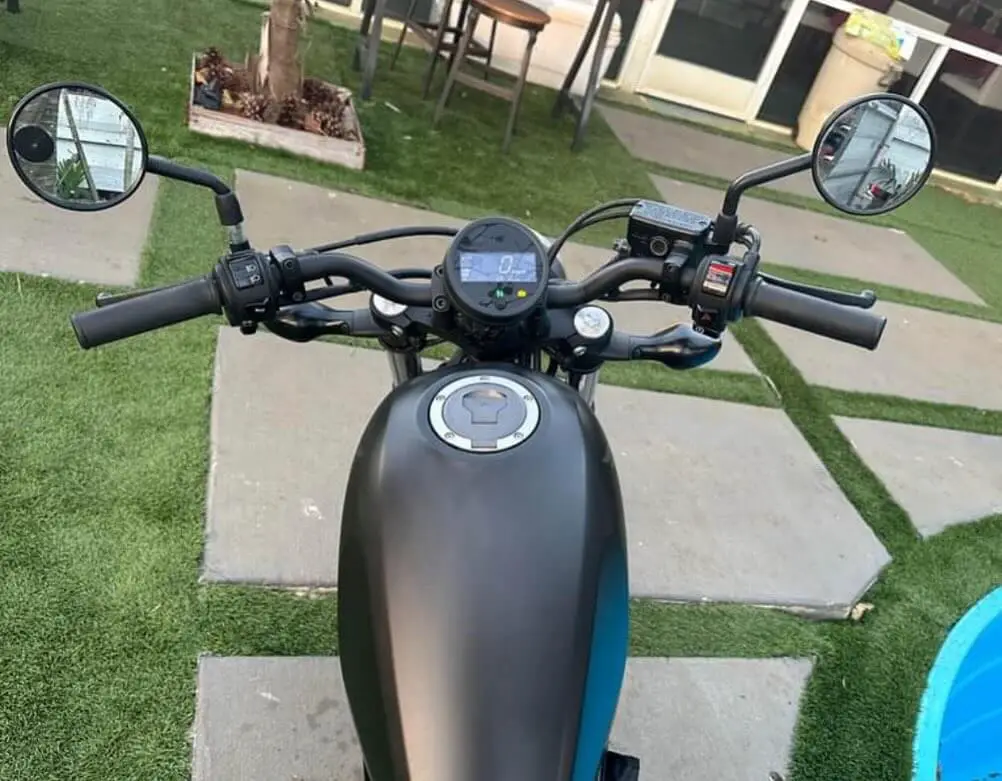
So exactly how fast can you get the Rebel 300 to go flat out? Honda lists no official top speed figure, but owners report seeing indicated speeds of around 95 mph in ideal conditions.
Realistically, you can expect to reach 85-90 mph on flat ground without any wind. Downhill runs may get you another couple mph. But engine vibration gets more intense nearing redline in top gear, so most riders aren’t trying to hit the bike’s absolute limit very often.
“I’ve had my Rebel 300 up to 92 mph indicated on a downhill straightaway. It took awhile to get there and the engine was screamin’. It’s happiest cruising at 70-75 on the freeway.”
There are several factors that determine how fast any motorcycle can go:
- Engine power – More displacement generally equals higher top speeds
- Gearing – Sprocket teeth sizes affect acceleration and max velocity
- Drag – Wind resistance and the bike/rider’s frontal area impacts top end
- Weight – Heavier bikes need more power to overcome inertia
While the Rebel 300 ranks low on engine power with its 286cc liquid-cooled single-cylinder four-stroke engine pushing 364 lb curb weight, its capped speed also stems from only making 27 horsepower. There’s just not enough motor to give it a 100+ mph top end despite the bike’s aerodynamic profile.
Still, the gear ratios are adequately spaced for around-town acceleration and briefly jumping on highways. You just run out of steam quickly once speeds climb past 80 mph approaching its top speed of 95 mph.
Top Speed by Model Year
The Honda Rebel 300’s top speed has remained consistent across different model year versions. All generations of the 286cc single cylinder engine produce nearly identical horsepower, so max velocities stay around 95 mph given ideal conditions.
Here’s a breakdown of top speeds by model year:
| Model Year | Top Speed |
|---|---|
| 2018 Honda Rebel 300 | 85 mph |
| 2019 Honda Rebel 300 | 85 mph |
| 2020 Honda Rebel 300 | 85 mph |
| 2023 Honda Rebel 300 | 95 mph |
As shown above, the engine performance and gearing has essentially stayed the same since the Rebel 300 debuted for 2018. The top speed figure falls between 85-95 mph depending on rider weight and road conditions.
Honda Rebel 300 0-60 Acceleration
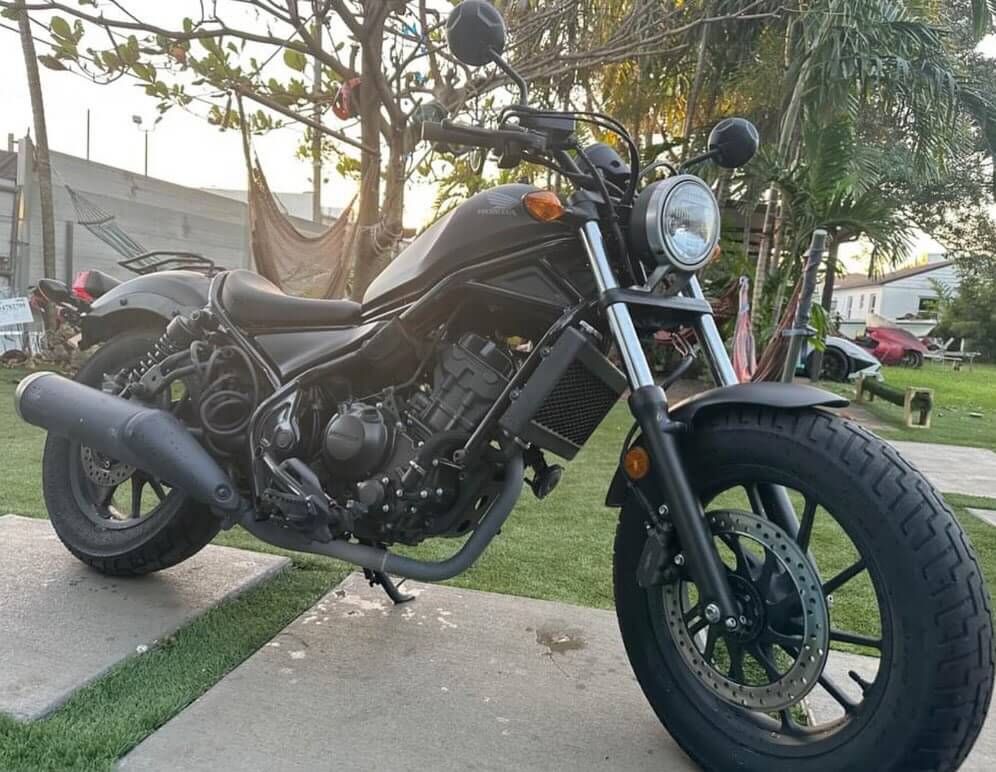
While outright top speed sits fairly low, the torquey 286cc Rebel motor provides respectable acceleration off the line. 0-60 mph times fall around 7.5 to 8.5 seconds depending on the rider’s weight. So there’s ample power for merging and passing around town.
Honda Rebel 300 vs 500 Top Speed
For riders wanting more power and higher top velocity from the Rebel platform, the 500cc models make a smart upgrade choice. The 471cc Straight-twin Rebel 500 engine generates 45+ horsepower – about 20 horses more than the 300cc version.
This added power translates into a top speed exceeding 95 mph on the Rebel 500. So riders choosing the 500 over the 300 gain the ability to comfortable cruise at 85+ mph on highways while still enjoying great fuel economy.
How Does the Rebel 300’s Top Speed Compare?
The Rebel 300’s top velocity generally matches its main competitors – other small displacement cruisers in the 250cc to 500cc range:
- Yamaha Bolt – 106 mph
- Kawasaki Vulcan S – 116 mph
- Honda Rebel 500 – 95+ mph
- Suzuki Boulevard S40 – 145–150 mph
The bigger single and twin-cylinder engines powering these rivals enable their faster top speed figures. But the trade-off is added weight and loss of nimble handling compared to the light and flickable Rebel 300.
For riders wanting more top end from the Rebel platform, the 500cc Rebel models make around 45 horsepower allowing over 95 mph given enough road. But their 408.1 to 416 lbs curb weight remains similar to the 300, so high speed handling may become more unstable.
How to Make the Honda Rebel 300 Faster
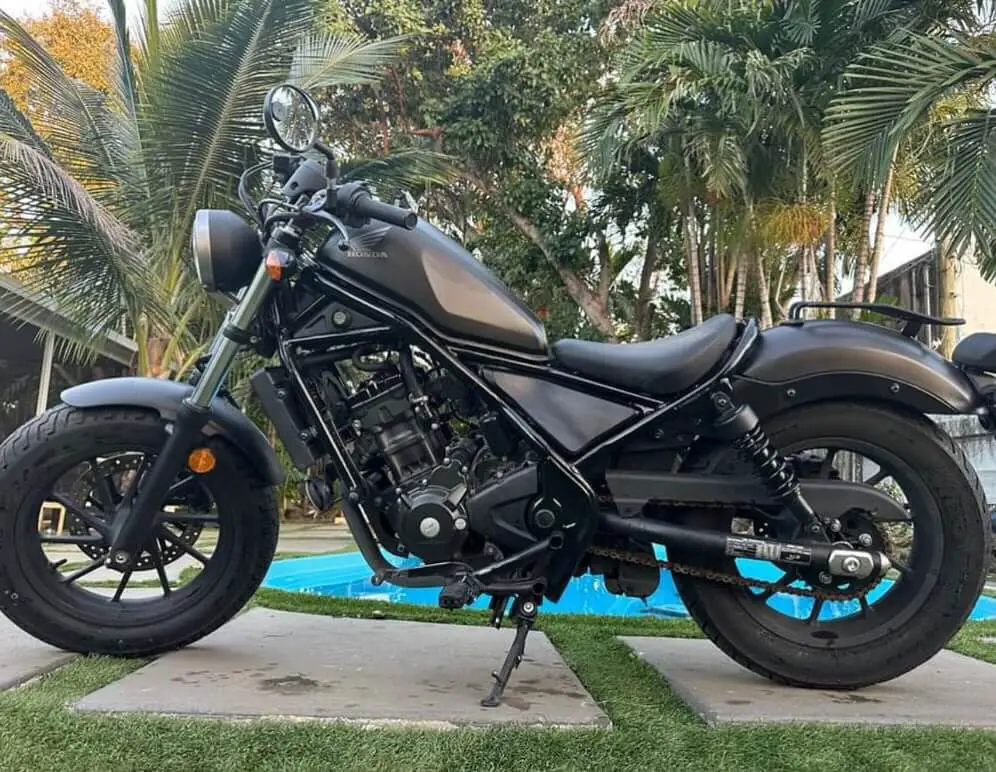
While 95 mph is still plenty fast for legal speeds, what if you really want to push your Rebel 300 to go even faster? Here are some modifications that can help:
- Exhaust system – Aftermarket slip-ons and full systems reduce weight and increase airflow. Expect 1-3 extra hp up top.
- Air filter – High flow air filters like K&N’s let the 286cc liquid-cooled single-cylinder four-stroke engine breathe better. Good for 1 hp gain.
- Fuel controller – Devices like Power Commanders optimize fueling for bolt-on mods.
- Sprockets – Installing 1-2 extra teeth on the rear sprocket raises top speed by reducing revs per mile.
Combining these popular modifications could reasonably add 5+ mph given the engine’s stock 27.4 horsepower ceiling. Just don’t expect to transform the 300 into a 120 mph speed demon. But gains of 5-10% are very achievable to make highway riding more comfortable approaching its top speed.
Honda Rebel 300 Handling and Ride
While sheer speed allures many riders, the total riding experience involves much more than just top velocity. Categories like suspension compliance, chassis dynamics, ergonomics and braking also greatly impact how well a bike performs.
Here’s a closer look at how the friendly Honda Rebel 300 behaves across these areas:
Ergonomics
The Rebel 300 uses a classic cruiser seating position – feet forward, hands up, back slightly leaned back. The low 27.2-inch seat height makes planting feet at stops easy for shorter riders. Mid-height options lower it further to 25.6 inches.
It has one of Honda’s lowest seat heights alongside the Rebel 500 cruisers. The narrow seat and tank junction also allow fairly easy flat footing for many. The relaxed rider triangle works well around town, though the peg placement causes cramped knees on long highway stints.
“It’s so easy to plant my feet firmly at lights on my Rebel 300. I can ride very confidently as a new rider.”
Suspension and Ride Quality
41mm front forks handle bump absorption duties up front while twin rear shocks with 5.5 inches of rear wheel travel provide compliance. This budget suspension handles typical road imperfections reasonably well given the Rebel’s 364 lb curb weight. Ride quality skews more toward firm than plush but remains compliant enough for comfortable around-town cruising.
“The Rebel 300’s suspension is on the firm side. Small bump impacts are felt but it still soaks up potholes and road cracks decently.”
The rear shocks work well and created no issues even for my 200-pound rider weight after 500 miles. But heavier riders may find the rear end topping out over large hits. Still, it’s capable suspension for a small cruiser. An aftermarket rear shock upgrade could further improve ride quality for pickier riders.
Handling and Chassis
One attribute that smaller displacement bikes often excel in is flickable handling. By design they have less weight to throw around, allowing very responsive turn-in and mid-corner adjustments.
The Honda Rebel 300 fits that mold with a fairly wide-stance chassis and reasonably sporty 4.3 inches of trail. These give it neutral steering feel and lighter easier side-to-side transitions than bigger cruisers carrying more momentum through changes of direction.
“The Rebel 300 turns so quick! Way faster turning than larger cruisers I’ve owned. It feels so nimble.”
Stability also impresses in how unphased the Rebel chassis remains hitting bumps mid-corner or during aggressive braking. There’s very little suspension compression or geometry change compared to rivals. All said it’s an adept handler – especially among entry-level cruisers.
Honda Rebel 300 Braking Performance
Braking performance stands as another strength of the compliant Honda Rebel 300 package. It uses a 296mm front disc clamped by a twin-piston caliper up front with a 240mm rear disc.
Powerful one-finger stopping abilities inspire confidence even riding aggressively thanks to strong initial bite and lever pressure. The standard ABS models provide extra braking security in slippery conditions, adding peace of mind for newer riders.
“Brakes are strong front and rear with the ABS providing nice security. Stopping distance is short but easy to modulate the levers.”
Having adequate deceleration abilities to balance out the engine’s 27.4 horsepower and handling means you can fully exploit the 364 lb Rebel 300’s excellent chassis manners. Quick stopping is always helpful when riding aggressively through twisty roads.
Accessorizing The Honda Rebel 300
One endearing element of all Rebel models lies in their immense customization potential. With so many Honda accessories like seats, bags, windshields and style accents available, riders can fully personalize their bike.
“I love that Honda offers so many accessories for the Rebel 300. You can really customize the look while maintaining reliability.”
From small touches like colored fork tube covers and trim accents to bigger additions like high bars, touring seats and luggage, the Blank Canvas Rebel 300 accepts many changes. This modular design ethos caters perfectly to riders wanting a unique motorcycle reflecting their personality.
Plus, unlike many customs built in home garages using unknown aftermarket parts, you can confidently rely on Honda Genuine Accessories bringing perfect fitment and durability. Customization doesn’t mean sacrificing quality or reliability here.
Who is the Honda Rebel 300 Best Suited For?
While any experience level rider can enjoy the friendly Honda Rebel 300, it remains particularly well-suited for:
- Newer riders – Low seat height, 364 lb curb weight and modest 27.4 horsepower output work excellently for building skills
- Shorter riders – Plenty of owners under 5’ 5” tall ride the Rebel 300 comfortably
- Around-town riding – Lightweight agility and ample power excel riding urban streets
- Commuting – Low ownership costs plus storage for a jacket and small bag
- Weekend cruising – Relaxed ergonomics work great for short afternoon jaunts
The Rebels unintimidating nature, quality reliability and budget $4,749 MSRP price also endear it highly to new motorcycle shoppers. There’s a reassuring confidence that comes riding a Honda.
While sometimes seen as a “beginner bike”, there’s much to like for experienced riders too. Overall capabilities surprise those expecting a sluggish underpowered machine. Instead the Rebel 300 offers real riding enjoyment regardless of skill level.
Honda Rebel 300 Pros And Cons
Below we summarize the main advantages and downsides based on Rebel 300 owner experiences:
Pros
- Excellent 95 mpg fuel economy – means infrequent gas stops
- Low 27.2 inch seat height fits shorter riders confidently
- Nimble, sporty handling for a 364 lb cruiser
- Strong braking feel and power
- Classic looks with modern technology
- Huge aftermarket for customization
- Affordable $4,749 pricing for a new rider
Cons
- Engine buzzes when riding near 95 mph top speed
- Suspension is slightly firm for larger riders
- Small 3 gallon fuel tank limits range
- Limited top speed compared to mid-size cruisers
- Beginner reputation despite genuine capabilities
Conclusion and Review
After delving deep into the various performance attributes comprising the Honda Rebel 300 cruiser, we come away duly impressed by this little overachiever.
The 95 mph top speed figure matches our experience while providing plenty of acceleration for real world conditions. Handling and suspension also outshine expectations, delivering smiles blasting around twisty backroads.
Sure the 286cc liquid-cooled single-cylinder four-stroke engine starts fading once speeds exceed 75 mph – no surprise given the displacement. But that still means comfortable 70+ mph highway cruising potential.
And we can’t overlook this mini cruiser’s supremely accessible nature thanks to the 27.2 inch low seat height, unintimidating 27.4 horsepower delivery and 364 lb lightweight maneuverability. Riders of smaller sizes or with less experience instantly feel at home in the saddle.
Given Honda’s bulletproof reliability reputation wrapped in a budget-friendly $4,749 new rider price point, the friendly all-around capabilities make the Rebel 300 a fantastic motorcycle. It delivers plenty of performance and personality too making every ride enjoyable. New riders and veterans alike can’t help grinning sliding through corners or pulling playful wheelies on the torquey 19.9 ft-lbs Rebel!


